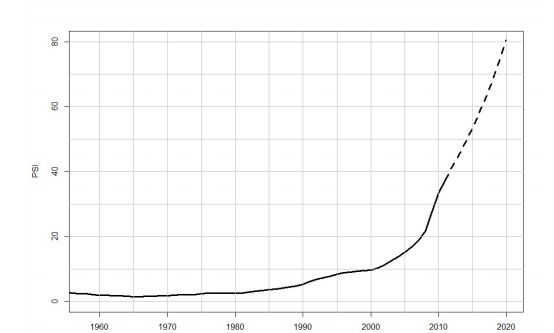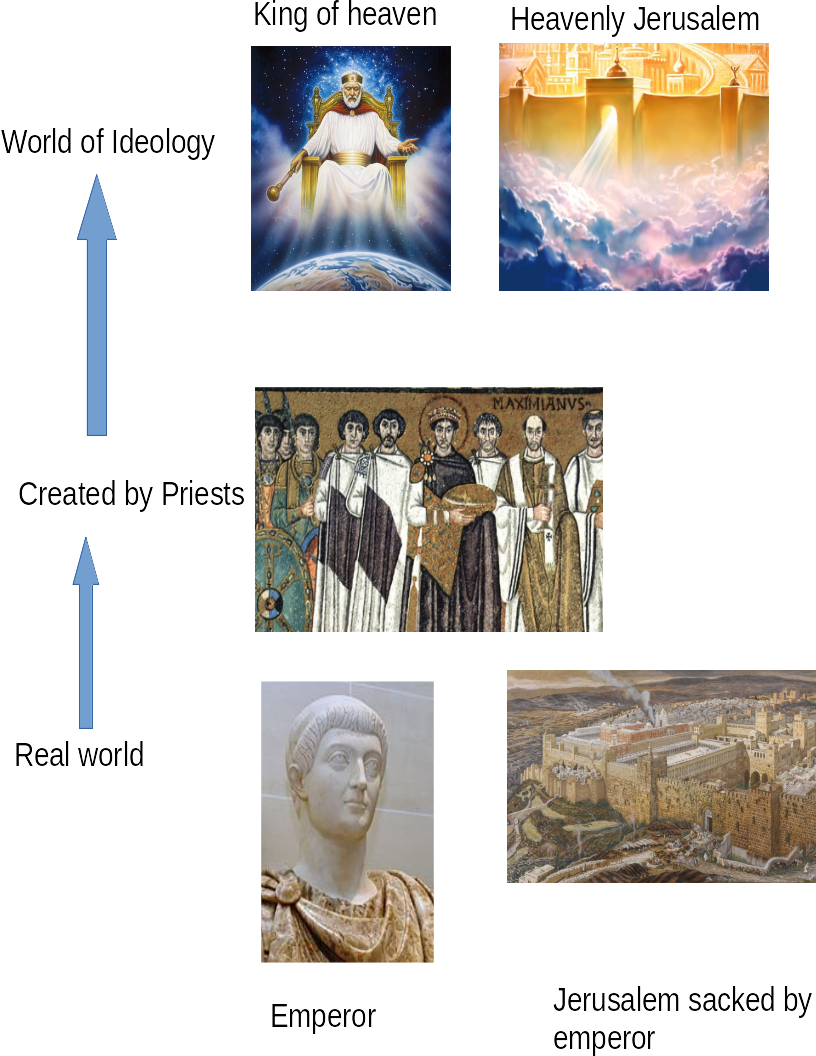
Paul Cockshott
July 6, 2019
Introduction
This is the second part of my critique of Althusser’s theory of ideology. It is a bit more technical than the last since Althusser gives a very abstruse definition of ideology and it needs a fair bit of formal and pictorial analysis to pick it apart.
What is the meaning of the word ’ideology’ in the article by Althusser?
Ideology represents the imaginary relationship of individuals to their real conditions of existence.3
Allowing that there is an element of the imaginary in his definition he first disposes of what he takes to be two false theories of ideology:
- That ideology is a set of beautiful lies produced by priests and despots to secure their rule. In this theory, the gods are the imaginary representation of real kings.
- That ideology is produced by material alienation which reigns in the conditions of existence of men themselves. In this theory, God is the projected essence of the real man in the abstract.
He characterises (1) as the mechanistic eighteenth century theory and (2) as the Feuerbachian and early Marx theory.
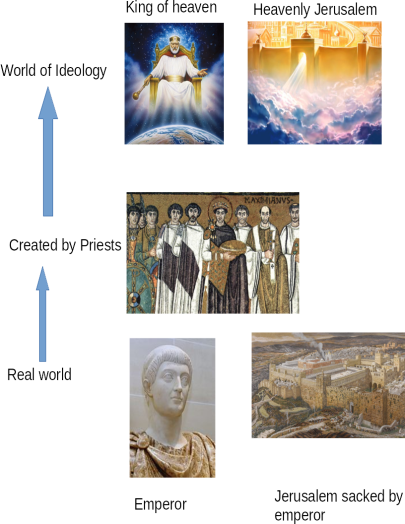
Figure 4: Althusser rejects as mechanistic the account that ideology was created by priests to help despots, and that the elements of ideology are reflections of the real world.
Let us leave aside Feuerbach. Why does Althusser reject what he disparages as the mechanistic theory that priests and agents of the kings created ideologies to cement their rule?
All these interpretations thus take literally the thesis, which they presuppose, and on which they depend, i.e. that what is reflected in the imaginary representation of the world found in an ideology is the conditions of existence of men, i.e. their real world.
Now I can return to a thesis which I have already advanced: it is not their real conditions of existence, their real world, that ‘men’ ‘represent to themselves’ in ideology, but above all it is their relation to those conditions of existence which is represented to them there.
Is this an adequate justification. Surely not. All that he is doing in the second paragraph quoted here is saying that the priest and despot theory contradicts his prior definition of ideology as representing an imaginary relationship to real conditions. But what he has to do is show why his theory is right and the ’mechanistic’ one is wrong. One can readily find in the Bible lots of imaginary or allegorical representations of real society at the time it was written. You can almost arbitrarily select Bible passages and find them making imaginary representations of real society.
2:11 Let the woman learn in silence with all subjection.
2:12 But I suffer not a woman to teach, nor to usurp authority over the man, but to be in silence.
2:13 For Adam was first formed, then Eve.
2:14 And Adam was not deceived, but the woman being deceived was in the transgression.
2:15 Notwithstanding she shall be saved in childbearing, if they continue in faith and charity and holiness with sobriety.( Epistle of Paul to Timothy)
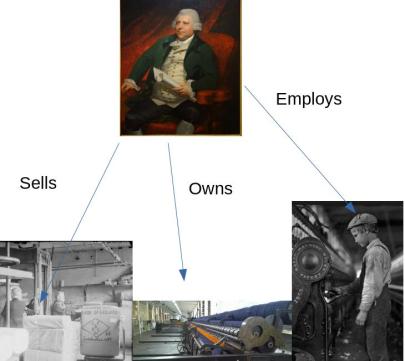
Figure 7: Althusser’s account of ideology starts with the real relations of production. A capitalist employs workers to use machines that he owns to make a product that the capitalist then sells for a profit.
That seems a to be a reflection of the real subordination of women in first century Judea, justified by the imaginary story of Eve.
4:12 For the word of God is quick, and powerful, and sharper than any twoedged sword, piercing even to the dividing asunder of soul and spirit, and of the joints and marrow, and is a discerner of the thoughts and intents of the heart.
4:13 Neither is there any creature that is not manifest in his sight: but all things are naked and opened unto the eyes of him with whom we have to do.
4:14 Seeing then that we have a great high priest, that is passed into the heavens, Jesus the Son of God, let us hold fast our profession.
4:15 For we have not an high priest which cannot be touched with the feeling of our infirmities; but was in all points tempted like as we are, yet without sin.(The Epistle of Paul the Apostle to Philemon)
This is drawing heavily on the real world with which Paul’s readers will have been familiar. They knew well the twoedged swords of the Roman legions, they knew of real high priests. Paul is claiming that Jesus is an imaginary high priest in heaven. He is also claiming that he is the ’Son of God’, and God is conventionally described as ’Lord God’, a form of address given to an actual dominus or master of slaves. So whe have God as an imaginary master of slaves, and Jesus as the imaginary descendant and thus inheritor of this master. All these social roles projected into the skies are ones that existed in the real world when the text was written.
3:12 Him that overcometh will I make a pillar in the temple of my God, and he shall go no more out: and I will write upon him the name of my God, and the name of the city of my God, which is new Jerusalem, which cometh down out of heaven from my God: and I will write upon him my new name.(The Revelation of Saint John the Devine)
Things that existed in the real world, Lords, patriarchs, cities temples are all projected into an imaginary world. And who wrote this?
It was precisely those priests that the ’mechanistic’ account of the 18th century claimed. Indeed the case can be made that the Gospels were drafted by employees of the Flavian emperors to quieten the rebellious Jews[5] . Even if you reject the Atwill thesis, there is no doubt that by the time of Constantine that Christianity had become, to use Althusser’s terms, an Ideological State Apparatus of the Roman Empire. As such, like any other state machine, it had its quota of what Lenin called ’special bodies of armed men, prisons etc’4. But the special bodies of men were armed with bibles and instead of literal prisons they had churches to imprison minds. Historically there is no doubt that the doctrines of the Christians were penned by preachers and priests, and that it did serve the despotic emperors of Rome. This mechanistic picture of ideology is shown in Figure 6 .
So why does Althusser reject the priests and despots account?
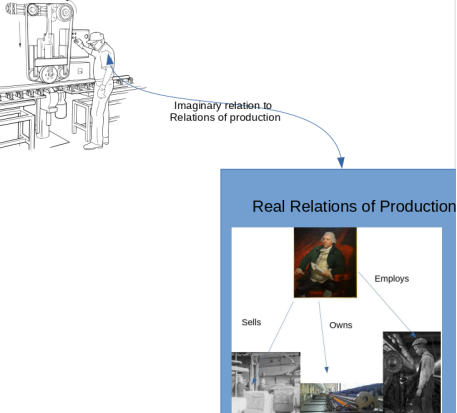
Figure 8: He then says that there is an imaginary relation of the individual to the real relations of production that were shown in Figure 7 .
I have tried to represent Althusser’s own much more complicated account in Figures 7 to 9 .
My illustration had to have a little creativity in filling the gaps because Althusser gives a very sketchy account indeed of what he means. But he is explicit that he rejects the idea that ideology represents the real world in an imaginary form. Instead, it is a representation of an imaginary relationship to the real relationships of production. So I started in Figure 7 with a picture of real capitalist relations of production.
In what follows I will try giving Althusser the benefit of the doubt. I will see if, by paying close attention to the specific way he defines ideology, any logically coherent account can be derived. Since I am teasing out definitions I give a fairly formal analysis. I use concepts from formal relational analysis, something that developed in the 1970s when IBM needed to concretely represent capitalist production relations and property relations in computers. This gave rise to relational algebra and relational database systems. It is now the case that the majority of capitalist property relations have their existence as relations in relational databases. Consider for a moment what would happen if a vast magnetic storm wiped out all the computers holding bank, stock control, and purchase order databases across the world, and you will see what I mean.
First, what is a relation?
Technically a relation is a set of tuples. It is the set of all things that are ‘related’ in a particular way. The capitalist relation of production involves 4 elements: Employer, Worker, Means of production and product. Let us denote this relation by R and give an example: R=
| Capitalist | Worker | Means of production | Product |
| Mr Arkwright | Annie McCleod | Spinning Mule | Cotton yarn |
| Mr Naysmith | John Smith | Steam Hammer | Iron forgings |
| Mr Stevenson | Robert Kerr | Steam Locomotive | Transportation |
So Master(Mr) Arkwright employs Annie to use a spinning mule to produce spun cotton yarn. Mr Naysmith employs John Smith to use a steam hammer to make iron forgings etc. The capitalist relation of production is the set of all the quadruples of these elements that actually operate at a given point in time.
R is the bare bones of the relation shown in Figure 7 . Perhaps, if we follow Marx’s analysis, the relation should be extended to include the value of the wage, the value of means of production used up, and the value of the product created by the labour. Let me call this extended version of the capitalist relation of production Re. So let me add some plausible victorian figures in £/s/d to fill it out.
. Re=
| Capitalist | Worker | Means of production | Product | v | c | c+v+s |
| Mr Arkwright | Annie McCleod | Spinning Mule | Cotton yarn | 2/- | 5/- | 9/- |
| Mr Naysmith | John Smith | Steam Hammer | Iron forgings | 2/6 | £1/2/6 | £1/8/3 |
| Mr Brunel | Robert Kerr | Steam Locomotive | Transportation | 4/- | 16/- | £1/4/- |
The table above uses the notation from Marx’s Capital where v stands for wages, c for capital in the form of means of production used up, and s for the surplus value or profit that the capitalist makes by employing the worker.
All of this, plus lots of more rows for all the other workers employed in 1848, was the real capitalist relation of production R in Britain.
According to Althusser the next step is for there to be an imaginary relationship between individuals and the real capitalist relation of production. I have attempted to illustrate it schematically in Figure 8 .
The diagram is rather unsatisfactory because this ’imaginary relationship’ is just shown as an arrow. The problem is that Althusser never gives any example of what he means by an imaginary relationship between a worker and the real capitalist relation of production. I could fill in the real capitalist relation of production by referring to what Marx wrote in Capital. But there is nothing so specific provided in Lenin and Philosophy about the content of the imaginary relation between the worker and the real relation of production. What we can deduce from what he writes is that he defines it as a binary relationship involving individuals on the one hand and the capitalist relation of production on the other. So lets call this Imaginary relationship I and give a hypothetical tabulation of it:
I=
| Individual | Relation of production |
| Annie | R |
| Arkwright | R |
| Brunel | R |
| John | R |
| Naysmith | R |
| Robert | R |
I am taking Althusser literally at his word here. But it is apparent that the resulting relation has very little content. Every individual stands in the one relationship to the same capitalist relation of production.
It was established when people were working on semantic modelling in the 70s and 80s that if you want to model any but the most vestigial semantics you need at least a ternary relation. If you have a ternary relation then you can model any semantics.
Consider for example the language Lisp, which, being Turing complete has general semantic representation ability. Its basic structure is a store of the form of a ternary relation:
| Address | CAR | CDR |
But let us leave that objection aside, and allow Althusser his vacuous binary relation. What could such a binary relationship be?
Could it be the set of all individuals who think they benefit from capitalism?
Does it just say that all individual in England in 1848 must have had some imaginary relation to the real capitalist relation since they lived in a capitalist system?
Should there be more than one imaginary relationship: one for all the workers, one for all the employers?
Should there be an extra imaginary relationship for all individual who are involved in pre-capitalist production?
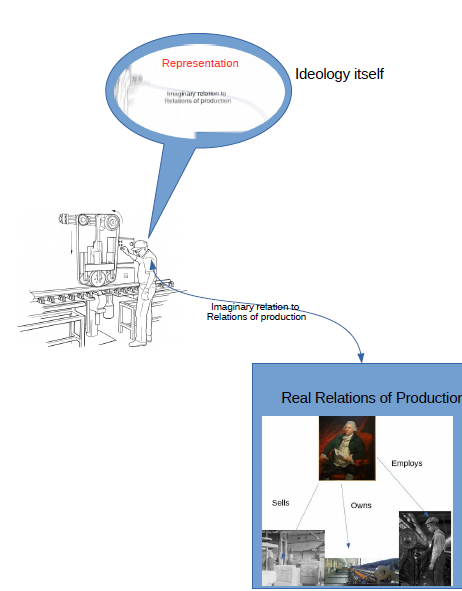
Figure 9: Althussers whole Monty is then that ideology itself is a representation of the imaginary relationship shown in Figure 8 .
Althusser does not say. He just says that ideology is a representation of a relation to a relation. Trying to make the best of a bad job, that is what I try to illustrate in Figure 9 . I show the ideological representation of the imaginary relationship as slightly blurry since representation is less, in information terms, than the thing it represents.
At first sight, Althusser’s account seems to be of high complexity, but that would not have mattered if it had been spelt out in sufficient detail to provide a plausible account. Lets see if we can make sense of it. He emphasises that ideology is about the imagined relationship of individuals to the relations of production. So lets take an individual from the tables and try out various interpretations of what he says. Let us start with Annie Macleod.
Does Annie have an imaginary relationship with, the capitalist relations of production?
Considering that includes all the capitalists, all the machines and all the products, it is pretty safe to say that Annie has no imaginary representation of it. But if we select out only the row
| Capitalist | Worker | Means of production | Product |
| Mr Arkwright | Annie McCleod | Spinning Mule | Cotton yarn |
then yes. She will be able to imagine this. Althusser says that ideology is the representation of an imagined relationship. If asked who her employer was, Annie could have answered ’Mr Arkwright’. If asked what she made she could have answered ’yarn’. If asked how she could have said ’with a mule’.
So she could have reconstructed in her imagination who employed her, to make what and with what and, by answering, she would give a spoken representation of her imagined employment and activity. So would the answering of these questions correspond to what Althusser calls ideology?
No. Because she is answering about her imagined recollection of her real work and her real employer. He says ideology is about imaginary relations to real relations.
the question of the ‘cause’ of the imaginary distortion of the real relations in ideology disappears and must be replaced by a different question: why is the representation given to individuals of their (individual) relation to the social relations which govern their conditions of existence and their collective and individual life necessarily an imaginary relation?
( my italics, WPC)
So it is not enough for Annie to be able to imagine Mr Arkwright, she has to imagine a relationship to the relationship between her and Mr Arkwright if her imaginings are to count as an ideology for Althusser.
Well, one possible example would be the following.
- Annie gets up in the morning and her mother gives her a bowl of porridge
- As she eats it she imagines what will happen if she is slow eating it and arrives late at the mill.
- She imagines Mr Arkwright scolding her and taking 6d from her day’s wage.
- She says ’Mother I must hurry or I will be late and lose pay’.
So here the imagined relationship is her failure to meet her real employment contract. She imagines it happening before the event and modifies her behaviour. The utterance ’I must hurry or I will be late’, then fits Althusser’s criterion for ideology.
I don’t doubt that things like this happen. Most of us have probably heard people worry about being late or losing pay.
This sort of example also fits in with the emphasis that Althusser gives on ideology being ’materialised in practices’.
an ideology always exists in an apparatus, and its practice, or practices. This existence is material.
Since Althusser counts the family as a state ideological machine and since eating breakfast is a practice, we can perhaps fit Annie’s complaint over porridge into his procrustean bed, but it is a forced fit. An adult worker living alone who muttered something similar over her porridge could hardly count as ’existing in the practice of an apparatus’.
The real problem is that Althusser has so narrowly specified what he counts as ideology that he omits most of what we normally mean by ideology. Consider some Trump tweets:
- The Economy is the BEST IT HAS EVER BEEN! Even much of the Fake News is giving me credit for that!
- As most people are aware, according to the Polls, I won EVERY debate, including the three with Crooked Hillary Clinton, despite the fact that in the first debate, they modulated the sound on me, and got caught. This crew looks somewhat easier than Crooked, but you never know?
- The cost of our great Salute to America tomorrow will be very little compared to what it is worth. We own the planes, we have the pilots, the airport is right next door (Andrews), all we need is the fuel. We own the tanks and all. Fireworks are donated by two of the greats. Nice!
At a pinch we could say that (1) meets Althusser’s definition, since it may lead people to imagine that they personally are doing better out of the economic system than they really are. But it is easier to see it meeting the ’mechanistic’ model of ideology where a despot creates an imaginary representation of the real economy.
Number (2) is ideological in the everyday sense, but fails according the Althusserian definition, since it is not about the relations of production. It would only count if we see it as an imagined relationship to Trump’s own real ’relations of production’ as a candidate. But that is not the purpose of the tweet. The purpose is to win other voter’s to support him.
Number (3) fits the mechanistic model since it invites the readers to imagine that they own the US tanks and planes. His readers have no power of disposal over tanks and planes. It is like Annie imagining she was Mr Arkwright and owned the spinning mill or imagining that you have won the lottery, or imagining that the Kingdom of Heaven is at hand and you can live in idleness forever after. For it to be an ideology for Althusser it must be an imagined relationship between the individual and other relations, not a simple counterfactual.
Take the quotations from the New Testament that I gave earlier. Do any of these correspond to an imagined relation between the individual and a real relation of production?
No. They scarcely touch on relations of production. Where they, at a pinch, do in the Epistle of Paul to Timothy they simply describe the relation of subordination of women to men. They do not describe an imagined relationship to this real subordination.
Conclusion to section 2.1
Althusser fails to give any convincing account why the ’mechanistic’ theory of ideology is wrong. He asserts a new definition of ideology that is over complex and so proscriptive that most of what we normally call ideology is excluded by it.
To come…
3 Pashukanis and Marxist legal theory
4 Against Althusser’s subject theory
References and notes follow from the first part of the article.
[1] Louis Althusser. Contradiction and overdetermination. For Marx, 114, 1969. [2] Louis Althusser. Ideology and Ideological State Apparatuses. In Lenin and philosophy. New Left Books, 1971. [3] Louis Althusser. Lenin and Philosophy. In Lenin and philosophy. New Left Books, 1971. [4] Louis Althusser. On the reproduction of capitalism: Ideology and ideological state apparatuses. Verso Trade, 2014. [5] Joseph Atwill. Caesar’s Messiah: The Roman Conspiracy to Invent Jesus. Ulysses Press Berkeley, CA, 2005. [6] Daniel Dennet. Consciousness Explained. Little Brown, Boston, 1991. [7] Evald Vasilyevich Ilyenkov. The dialectics of the abstract and the concrete in Marx’s Capital. Aakar Books, 2008. [8] Vladimir Illich Lenin. State and revolution. Haymarket Books, 2015. [9] Zedong Mao. On Contradiction. 1953. [10] Karl Marx. Capital, volume 1. Progress Publishers, Moscow, 1954. Original English edition published in 1887. [11] Alan Sinfield. Cultural Materialism, Othello and the politics of plausibility. 2003.1By way of contrast, Google gives 599 citations to the main work[7] of the Soviet philosopher Ilyenkov and over fourteen thousand to the main work[6] of the US materialist Dennet.
2At more length in [4] .
Engels elucidates the concept of the “power” which is called the state, a power which arose from society but places itself above it and alienates itself more and more from it. What does this power mainly consist of? It consists of special bodies of armed men having prisons, etc., at their command. We are justified in speaking of special bodies of armed men, because the public power which is an attribute of every state “does not directly coincide” with the armed population, with its “selfacting armed organization”[8] .
